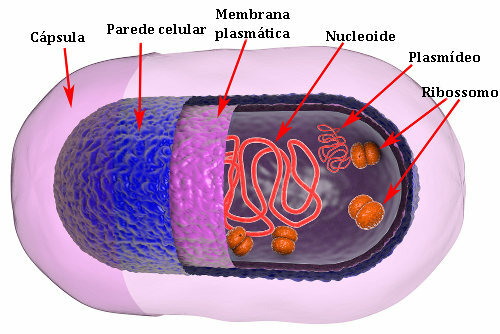You prokaryotic organisms do not have a defined core in their cells and, in this way, the genetic material of these beings is dispersed in the cytoplasm. This feature is observed, for example, in bacteria and cyanobacteria.In these organisms, there is the presence of a nucleoid.
→ What is a nucleoid?
Nucleoid is the region where the genetic material of prokaryotic organisms is located.. This structure can be spherical, elongated, or dumbbell-shaped. The nucleoid is composed of the condensed genome, which forms, in bacteria, the so-called bacterial chromosome. The genome usually has a single molecule of DNA double tape, circular and capable of self-duplication.

Note the presence of the nucleoid and plasmids in the prokaryote cell. Plasmids are a type of extrachromosomal DNA
In this DNA, introns are not found, that is, the elements of a gene's DNA that do not encode any part of the protein produced by that gene. Bacterial DNA also lacks histones, which are proteins found in eukaryotic cells responsible for the compaction and decompression process of DNA.
In the nucleoid are found all the genes necessary for the cell to be able to carry out its activities, that is, it is in this place that the essential genetic information for the survival of the body. It is worth noting that, in addition to the genetic material available in the nucleoid, there is also extrachromosomal DNA.
-
extrachromosomal DNA
Plasmids are circular extrachromosomal DNA molecules that are located throughout the cytoplasm and replicate independently of chromosomal DNA. These structures provide some adaptive capabilities to organisms, such as those that have the antibiotic resistance. Normally, a plasmid has only 5 to 100 genes and can be lost or acquired by the cell without causing much damage.
By Ma. Vanessa dos Santos
Source: Brazil School - https://brasilescola.uol.com.br/o-que-e/biologia/o-que-e-nucleoide.htm
